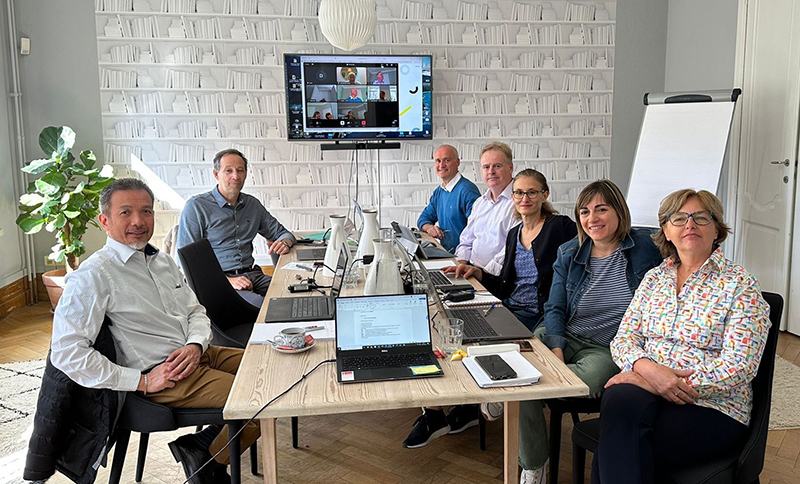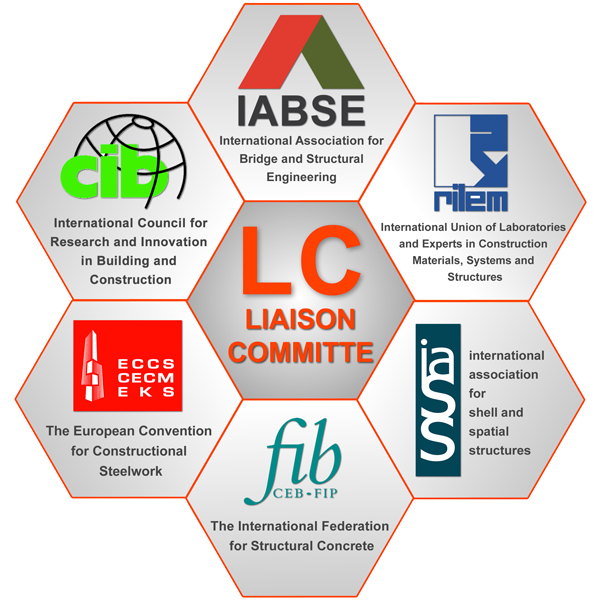The Liaison Committee of International Associations of Civil Engineering is a body initiating contact between international associations of civil engineering.
Formed in 1958, it brings together the member organisations: CIB ECCS fib IABSE IASS RILEM
Formed in 1958, it brings together the member organisations: CIB ECCS fib IABSE IASS RILEM

LC Meeting in Brussels, May 25-26, 2023
-
Aims and ResponsibilitiesThe Liaison Committee aims...to promote the coordination of the Members' activities to achieve optimum efficiency;
- to arrange relevant joint activities, including joint committees, Working Parties and Task Groups;
- to ensure effective cover of the various fields of interest of each Association without unnecessary duplication;
- to harmonise its Members' various activities and publications to achieve a greater impact and more awareness of the role of the Member Associations, and the work of their individual members, and thus, their significance to society.
It offers an opportunity for direct joint discussions on all projects likely to set favourable conditions for the development of members' activities and for technical advances in the field of civil engineering at international level. Meetings are conducted in such a way as to preserve the total independence of each association.The Liaison Committee has a formal meeting once a year, conducting the majority of its work through correspondence and direct contact between its Secretariat and those of the Member Associations. Special meetings are convened as necessary.The Liaison Committee is responsible for...- approving the overall Calender of Events - Congresses, Symposia, Colloquia, Workshops and other meetings - proposed by the Member Associations; it arranges for the publication and dissemination of this generally through its Members. Advance consideration of the Calendar of Events affords the opportunity for arranging more jointly sponsored and coordinated events. Adequate advance warning will be facilitated by the provision of a Joint Calendar every three months to assist in planning. For major events, such as Congresses, at least four years advance warning is necessary;
- identifying topics or projects suitable for joint action and setting-up and supporting joint Task Groups or Working Parties as necessary, the most important example was the setting up in 1971 of the Joint Committee for Structural Safety, whose work is monitored by the Liaison Committee;
- facilitate the exchange of publications between Member Associations and the provision of relevant news items for both internal and external distribution;
- establishing and promoting contacts with regional and international groups, in both the technical and political sense, which affect, or impinge on, its Members' work; this should aid the better directing of the overall activities;
- setting up, from time to time, review procedures in developing areas to assist in distributing tasks between the various Member Associations. This is obviously a joint activity of limited duration and with specific objectives.
-
Activities of the Liaison CommitteeExamples of cooperation of the Liaison Committee Member Associations:1. Joint Committee for the Globe Consensus. GLOBE.The Joint Committee on the GLOBE Consensus (GLOBE) is a committee dedicated to reducing Green House Gas (GHG) emissions from construction. GLOBE has been brought to life by six leading international construction engineering associations, responsible for technical guidelines, standards, innovation, research and education in construction at the international level for more than 50 years. They represent more than 150 nation states and 5000+ experts. Hence, the backbone of GLOBE is comprised by the knowledge represented by the associations with respect to the entire value chain of construction. This includes the expertise of material scientists, structural safety and resilience scientists, consulting engineers, contractors, owners and operators, experts in standards and codes, as well as policymakers.2. Joint Committee for Structural Safety JCSS, founded in 1971Probabilistic Assessment of Existing Structures, a Publication from the Joint Committee on Structural Safety (JCSS)The aim of the activities of the Joint Committee on Structural Safety (JCSS) is to promote matters within the field of structural reliability at an inter-association level. Reliability-based assessment of existing structures has been identified as a topic of major importance. In fact the assessment of existing structures is getting more and more important due to social and economic reasons, while most codes deal explicitly with design situations of new structures.The assessment of an existing structure may however differ from the design of a new one. Due to deterioration and damage, it is general practice to inspect existing structures, and if necessary, to repair and/or strengthen them. Although, various uncertainties related to loads and resistance parameters must be assessed, resulting in safe, codified design provisions, actual observations update the prior assessment. Assessing existing structures varies completely from that during design. Special attention is paid to specific parts of the existing structure and to limited parts with a real risk of damage, given the behaviour of the structure. Interpretation and the analysis of the additional information may not be a simple matter.Specific procedures and tools are required in order to judge the safety of existing structures. Such procedures and tools have been reviewed within this project of the JCSS and have been thoroughly discussed in various meetings during the last six years. A review resulted in the following goals:
- standardised methods and terminology
- operational for consulting engineers
- applicable for various materials and various structural types
- guide the pre-codification state, i.e. to build the basis of future codes, standards or code type of recommendations.
The results obtained within this project are documented in the present report. Although the nature of the report is educational, it contains practical and operational recommendations, and rules for the assessment of existing structures, illustrated with examples and real case studies.4. International Conference in Innsbruck, in September 1997 'Composite Construction - Conventional and Innovative'Structural engineering has experienced increasing specialisation. Structural forms and performance have often largely been dictated by the adopted material, rather than by the functional requirements of the structure. Functional considerations, however, will most often lead to the choice of different materials for different parts of a structure, and to combinations of materials that exploit their individual qualities to produce advantages that are greater than the sum of the parts. This is the essence of Composite Construction.The 1997 Innsbruck Conference was a joint effort of the main international associations of civil engineering (CEB, CIB, ECCS, FIP, IABSE, RILEM, ASCCS).This Conference Report provides an excellent overview of the many aspects of composite construction, ranging from combinations of traditional building materials to more unconventional structural materials such as fibre-reinforced plastics. The following themes are discussed:Connections between Materials / Safety and Serviceability / Analysis and Dimensioning / Structural Design / Fire Resistance / Joints between Structural Members / Fabrication and Erection / Codes and Standards / Earthquake Resistance / Diagnosis, Maintenance, Retrofitting, Repair / Advanced Composites / Behaviour Modelling5. International Conference in Malta, on March 21-23, 2001 'Safety Risk and Reliability - Trends in Engineering'The Conference in Malta, from March 21 to 23, 2001, was a joint event of the international associations of civil engineering, CIB, ECCS, fib, IABSE and RILEM; not a specialist conference, but a meeting place for 450 scientists and designers, from 50 countries, addressing the various aspects of safety, lifetime performance, and environmental aspects within design and operation of buildings and civil engineering structures:Structural Risk Assessment / Risk Engineering / Lessons from Failures / Structural Codes / Risk Acceptance Criteria/ Risk Control / Assessment of Existing Structures / Decision Support / Risk Communication /Project, Construction and Operation Risks / Reliability in Geotechnical Engineering/ Benchmark Studies.The 390 abstracts in response to the "Call for papers", resulted in 171 papers, the written proceedings containing 145 papers, printed in full (6 pages each), and about 26 long abstracts (2 pages each). The CD features all papers in full. The scope of the papers is wide. On the one hand, classical structural reliability aspects are covered, including codification of structural analysis, assessment of existing structures and geotechnical analysis. On the other, there are many papers dealing with items like risk analysis, acceptance criteria, decision support systems and risk communication. The relationship between structure-related risks and ethical, legal and insurance considerations is also presented. The proceedings of this conference are a valuable contribution to the process of making better and more rational risk-related decisions in civil engineering and building construction.Chairmanship and SecretariatEach Member Association is called upon in turn to put forward one of its representatives to chair the Liaison Committee for two years. The Secretary is nominated by the Committee and is alternatively the Secretary of one of the Member Associations.For the years 2022 and 2023, ECCS has the Chairmanship and Secretariat of the Liaison Committee.For more information, contact:ECCS SecretariatMs Véronique BAES-DEHANSecretary GeneralEuropean Convention for Constructional SteelworkAvenue des Ombrages 32, 1200 Brussels, BelgiumPhone: +32-2/762.04.29



